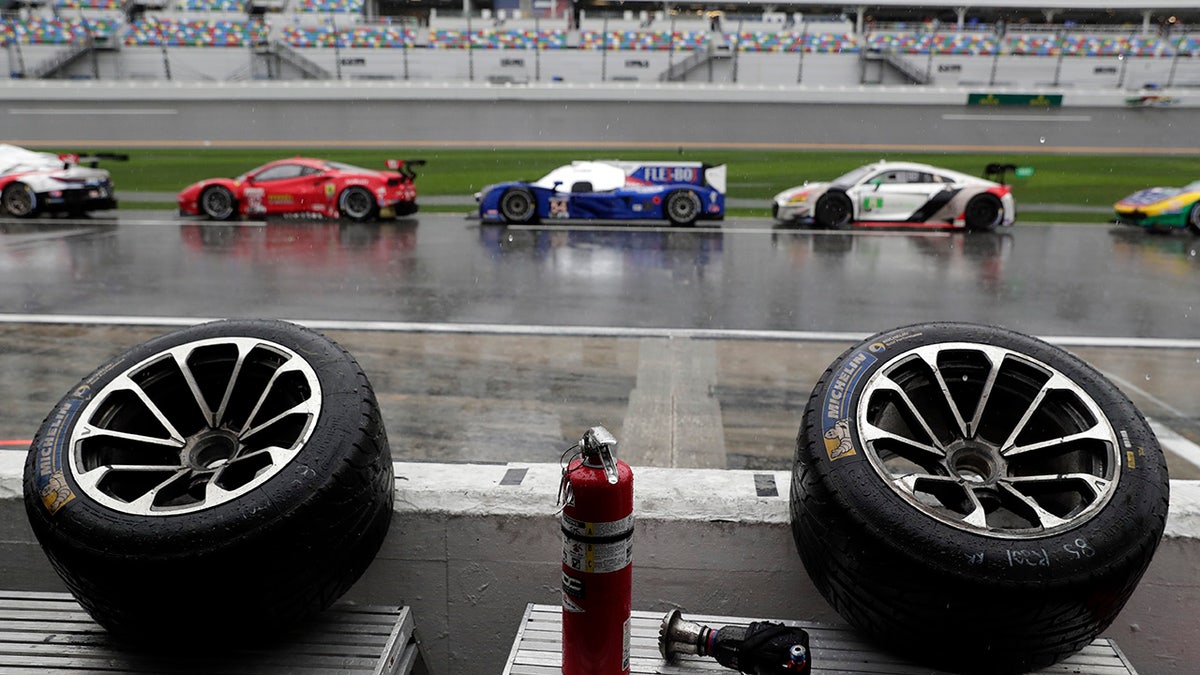
(AP)
Fernando Alonso deftly maneuvered through some of the most dangerous driving conditions of his career to grab another victory in a bucket-list event.
Alonso drove a Cadillac DPi to the front of the field in each of his three stints in the Rolex 24 at Daytona, including the final pass for the lead in a heavy rain, on a slick track, with almost no visibility. The race was red-flagged minutes after Alonso put Wayne Taylor Racing out front, and IMSA pulled the plug about two hours later.
The decision to call the race came 10 minutes before the scheduled conclusion and marked the first time rain prevented the Rolex from going the full 24 hours. It also was the first time in race history the event was stopped twice for red flags for rain.
Alonso was sitting under a blanket on the Taylor pit stand when the race was called.
"It's too bad we didn't get to race the full distance, but we led the race in night, day, dry, wet, so I think we all kind of deserve this one," he said.

(AP)
Alonso joined Phil Hill (1964) and Mario Andretti (1972) as F1 champions who also won the most prestigious sports car event in North America. Alonso, who has two F1 titles, retired from that series in November.
The Spaniard now has won the Rolex, the 24 Hours of Le Mans and the Monaco Grand Prix. The next big event on his schedule is the Indianapolis 500 in May, the one victory he needs to complete auto racing's unofficial version of the Triple Crown.
Wayne Taylor Racing now has four overall Rolex victories. The team won in 1996 and 2005 with team owner Wayne Taylor driving, and Jeff Gordon was part of its 2017 victory. The team this year brought in Alonso and Kamui Kobayashi, teammates on the Le Mans victory last June, to join full-time drivers Jordan Taylor and Renger van der Zande. Jordan Taylor was part of the winning team two years ago.
Alex Zanardi's return to a North American race for the first time since his legs were severed in a 2001 crash was hampered by mechanical problems, including an early electrical issue with the BMW-designed steering wheel that allowed the Italian to race without his prosthetic legs.
Zanardi used the wheel to accelerate, brake, shift and communicate with the car. Even though the Bobby Rahal-owned team finished 18 laps down in the GT Le Mans class, the venture was a success. Zanardi drove three times totaling 6 hours, 17 minutes; his final stint was disrupted by the heavy rain at daybreak.
"He shows very clearly that life isn't over and you can still go out and live and do whatever it is you want," Rahal said.
Rahal's second BMW M8 entry won the GTLM class with Augsto Farfus, Connor De Phillippi, Phillipp Eng and Colton Herta.
The LMP2 class was won by the No. 18 DragonSpeed Oreca with drivers Roberto Gonzalez, Pastor Maldonado, Sebastian Saavedra and Ryan Cullen, while the No. 11 Grasser Racing Team Lamborghini Huracan won the GT Daytona class for the second consecutive year with Rolf Ineichen, Mirko Bortolotti, Christian Englehart and Rik Breukers.
Alonso, meanwhile, was the heavyweight in the Wayne Taylor lineup and dazzled every time he got into the Cadillac. He competed in the Rolex last year as a warmup for Le Mans but returned this time intent on winning the Rolex watch. His first time in the rotation Saturday night was a triple stint in which he took the lead away from both of Roger Penske's Acura entries.
He drove again early Sunday morning and had the car out front for a lengthy yellow period that ultimately ended in the first stoppage for rain since 2004.
Alonso got the car back one final time to close out the race and took the lead when Felipe Nasr missed a turn and drove through a deep patch of water. Alonso stayed on course to move to the point, and when IMSA brought the cars to pit road minutes later under red, he walked under an umbrella to IMSA's pace car and leaned inside the open door to discuss the conditions with the driver.
Alonso then joined his teammates in the pits to await IMSA's decision.
"It was a very difficult race. The conditions were quite a shock sometimes," Alonso said. "You had to survive every lap. It wasn't a matter of lap times or anything like that. It was a matter of crossing the line, putting the lap together and at the end, it worked."